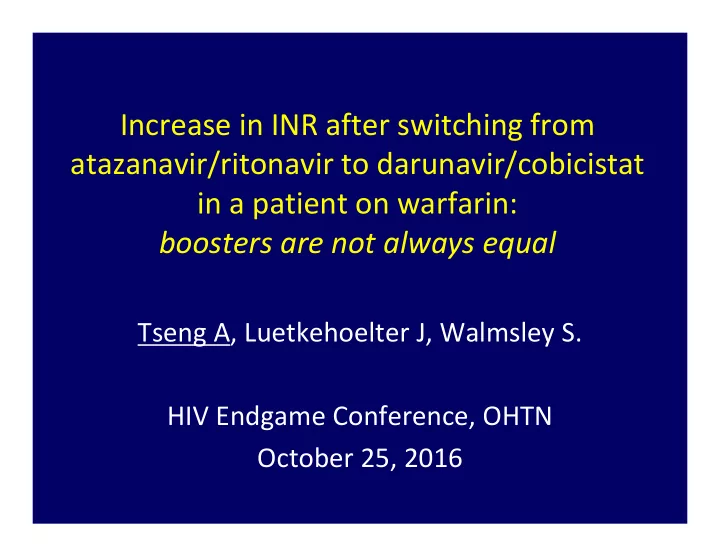

Increase in INR after switching from atazanavir/ritonavir to darunavir/cobicistat in a patient on warfarin: boosters are not always equal Tseng A, Luetkehoelter J, Walmsley S. HIV Endgame Conference, OHTN October 25, 2016
Disclosures • Unrestricted educational grants: – Abbvie, Bristol Myers Squibb, Gilead, Merck, ViiV • Speaker honoraria/consulting: – Abbvie, Gilead, Merck • Advisory board: – ViiV
Background • The oral anticoagulant warfarin is a racemic mixture comprised of: – R‐isomer, substrate of CYP1A2, 3A4 – S‐isomer, substrate of CYP2C9 • Potential for interactions with antiretrovirals including ritonavir, which induces 2C9 – case reports where 45‐100% warfarin dose required to maintain therapeutic INR after boosted PI therapy was initiated
Background/Purpose • In contrast to ritonavir, cobicistat does not induce CYP450 or transporter activity • We describe an HIV‐infected individual on stable warfarin who experienced increased international normalized ratio (INR) after switching from atazanavir/ritonavir to darunavir/cobicistat
Case • 72 year old Causasian male, HIV+ 1987, on atazanavr/ritonavir plus 2 NRTIs since 2005 with suppressed VL, current CD4 437 cells/mm3 – MI (1999, CABG 2012), DLBC lymphoma (2007 – CHOP), atrial flutter (2013), COPD/emphysema, neuropathy • Switched to darunavir/cobicistat/emtricitabine/TAF STR in September 2015 (study) – Concomitant meds: acyclovir, pravastatin, EC ASA, metoprolol, warfarin, Advair, salbutamol, pregabalin • Had been on stable warfarin dose of 10 mg daily for over the past year with a recent INR of 2.5 prior to antiretroviral switch
Case: INR & Warfarin Dosing Baseline: • 4 Warfarin 10 mg/d 12 • INR 2.5 3.5 10 Daily Warfarin Dose (mg) 3 8 2.5 INR 2 6 INR 1.5 4 Warfarin Dose 1 2 0.5 ATV/r‐TDF‐FTC DRV/cobi/FTC‐TAF 0 0 Jun‐15 Jul‐15 Aug‐15 Sep‐15 Oct‐15 Nov‐15 Dec‐15 Jan‐16 Feb‐16 Mar‐16 Apr‐16 • One month after switch, INR was 3.4 and warfarin to 8.75 mg/day • In January (4 months later), INR was 3.6, warfarin to 7.5 mg/day. Patient also reported recurrent nosebleeds • Warfarin further to 4 mg/day and INR returned to baseline
Using Warfarin with Antiretrovirals • Racemic mixture (R: CYP1A2, 3A, 2C19; S: 2C9) Impact on Warfarin Protease Inhibitors NNRTIs InSTIs Concentrations Warfarin due to Ritonavir: Nevirapine Elvitegravir 45‐100% warfarin 60% warfarin • • • Doubling/exceeding 2C9 induction dose to maintain max recommended dose to maintain INR warfarin dose INR (case report) Warfarin due to Efavirenz 4‐fold reduction • 2C9 inhibition in warfarin dose No impact Rilpivirine Dolutegravir Raltegravir • Close monitoring recommended, especially when starting/changing antiretrovirals Fulco et al. Pharmacother 2008;28:945‐9. Hughes et al. CMAJ 2007;177:357‐9. Dionisio et al. AIDS 2001;15:277‐8. Bonora et al. CID 2008;46:146‐7. Good et al. AIDS 2015;29:985‐6.
Note: Cobicistat Not Always Equal to Ritonavir PK Booster Substrate CYP450 and UGT Transporters (Inhibitor) Inhibitor Inducer Ritonavir CYP3A4, P‐gp, CYP3A4 UGT, CYP1A2, P‐gp, MRP1 (potent)>>2D6 CYP2C9, 2C19, OATP1B1/3, >2C9>2C19>2A 2B6 BCRP, 6>1A2>2E1 OATP2B1, OCT2 Cobicistat CYP3A4, 2D6 CYP3A4>> 2D6 none P‐gp, BCRP, (minor) OATP1B1/3, MATE1 • Generally, cobicistat 150 mg provides equivalent boosting to ritonavir 100 mg (but some exceptions) • One key difference is that cobicistat lacks significant enzyme inducing effects
Interaction Between Acenocoumarol and Antiretroviral Drugs • 56 yo male required 38% increase in acenocoumarol dose to maintain therapeutic INR while on atazanavir 300/100 mg daily. • When atazanavir/ritonavir was replaced with raltegravir, the acenocoumarol dose was reduced and therapeutic INR was maintained. • Mechanism: induction of • Acenocoumarol: oral vit. K antagonist CYP2C9 and 1A2 by – R enantiomer: 2C9>1A2, 2C9, 3A4 ritonavir – S enantiomer: 2C9 (no pharmacologic activity in vivo) Welzen MEB et al. Antiviral Ther 2011;16:249‐52.
Hypothesis: Warfarin Interaction with Darunavir/Cobicistat • Previously stable on warfarin 10mg daily while on atazanavir/ritonavir – Ritonavir induces 2C9, likely required higher warfarin dose • Switch to darunavir/cobicistat: no 2C9 enzyme induction effect – Led to increased warfarin concentrations and elevated INR with symptoms • A 60% in warfarin dose was required
Drug Interaction Probability Scale (DIPS) Total Score: 4 (possible) Horn et al. Ann Pharmacother 2007;41:674‐80 .
Discussion • While cobicistat and ritonavir have generally similar CYP3A4 inhibiting properties, cobicistat does not induce CYP isoenzymes or transporters – ritonavir induces CYP1A2, 2B6, 2C8, 2C9, 2C19 and UGT leads to drug concentrations and dose • When switching from ritonavir to cobicistat, may need to doses of drugs metabolized via these pathways – enzyme inducing effects may take 2‐3 weeks to dissipate – monitor and adjust (decrease) dose of target medication as needed
• Generally similar CYP3A4 inhibiting properties • Ritonavir induces CYP1A2, 2B6, 2C8, 2C9, 2C19 and UGT leads to concentrations and dose • Cobicistat does not induce enzymes • When switching from ritonavir cobicistat, may need to doses of drugs metabolized via these pathways
Examples of Medications Affected Differently by Ritonavir vs. Cobicistat Class Example Metabolic Pathway Ritonavir Cobicistat Effect Effect Anticoagulant warfarin 2C9>1A2, 3A4, 2C19 Antidepressant bupropion 2B6 ‐ / duloxetine 2D6, 1A2 sertraline 2B6>2C9/19, 2D6, 3A4 Antidiabetic sulfonyureas 2C9 ‐ Antipsychotic olanzapine 1A2, UGT1A4 ‐ Bronchodilator theophylline 1A2 ‐ Contraceptives EE, NE 3A4>2C9, UGT Immunosuppresant MMF UGT ‐ Lipid‐lowering Gemfibrozil, UGT ‐ fenofibrate, pitavastatin Adapted from: Marzolini et al. JAC 2016 [epub ahead of print]
Don’t forget what cobicistat is paired with Inhibiting effects Inducing effects Atazanavir Evotaz CYP3A, 2C8, UGT1A1 Darunavir Prezcobix, CYP3A CYP3A4 (?) DRV/co/F/TAF Elvitegravir Stribild CYP2C9 • Stribild monograph: • Case report: – 42 yo HIV+ male on efavirenz/TDF/FTC and stable warfarin 50 mg/wk for recurrent lower DVT; changed to Stribild due to CNS effects – On day 20, INR was subtherapeutic – Warfarin to 80 mg/wk to achieve therapeutic INR (= 60% dose ) – Suggests 2C9 induction by EVG outweighs CYP3A4 inhibition by cobicistat Good et al. AIDS 2015;29:985‐6.
Conclusions • When switching from a ritonavir‐ to a cobicistat‐boosted protease inhibitor regimen, clinicians should be aware of the potential for increased warfarin exposures • INR monitoring is recommended and warfarin dose adjustments may be required • Causality assessments (e.g., DIPS) may be helpful • Publish new observations!
Recommend
More recommend